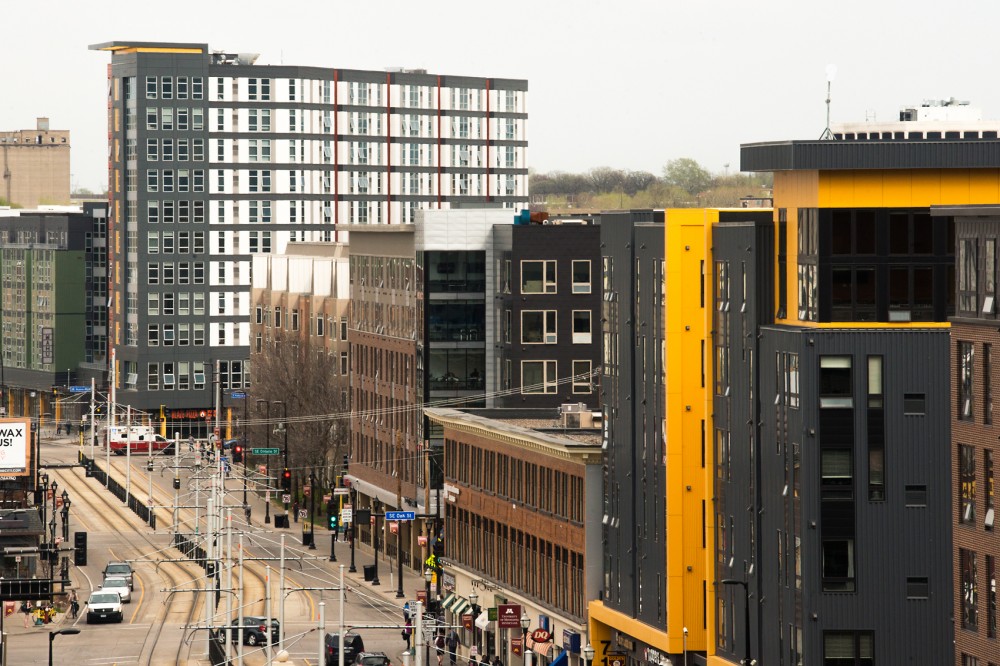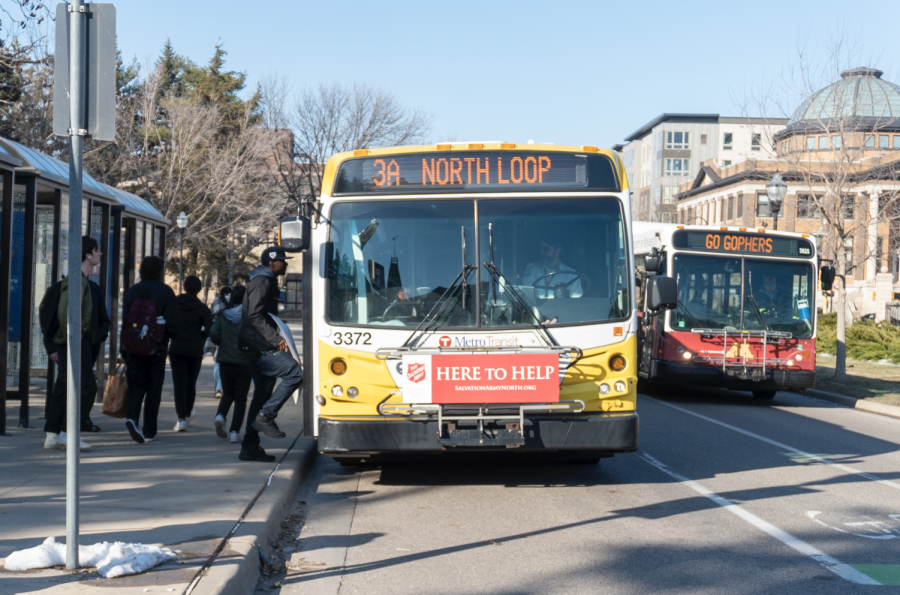Cydney Evert lived more lavishly than many of her fellow students at the University of Minnesota last semester.
Her luxury apartment complex, The Marshall, offered a pool, strength and conditioning center, basketball court, tanning deck, grilling stations and sand volleyball court.
The building has study rooms on each floor and a community computer lab.
“It’s also nice that they have security guards at night; they make you feel safer,” the architecture senior said.
The downside: a “ridiculous” price tag, according to her mother, Kyloe Evert, who foots the $740 monthly rent plus a transfer fee when her daughter studied abroad and had to sublease her room.
Still, it’s cheaper than senior Alexandra Naas’ studio apartment at The Bridges about six blocks away. She forks over $1,000 plus utility for amenities that include a movie theater, yoga studio, fitness center, game room and tanning booths.
The Marshall and The Bridges are two of at least 16 brand new or newly renovated luxury apartment complexes that have emerged near campus since 2010. The wave of high-priced, amenity-filled buildings have redefined not only the University-area look but student lifestyles, too.
The campus area ranked 12th in the country for most off-campus beds added since 2012, according to Dallas-based research company AXIOMetrics, which studies off-campus housing nationally.
The building boom in luxury apartments has created more than 2,300 plush units, more than half as many as the University offers in its nine residence halls and three apartment facilities.
But in style and price, the new digs are far from the average dorm room or traditional off-campus apartment.
Students who live on campus pay about $600 a month for double-occupancy dorm rooms, not including meal plans, and about $700 for single-occupancy rooms. In the nearby Marcy-Holmes neighborhood, the median rent for a studio apartment is about $640, according to research done for MinnPost and the Minnesota Daily by the Center for Urban and Regional Affairs (CURA). The median one-bedroom apartment is $750.
Students pay double that at many of the newer luxury high-rises, where the median price for a studio apartment is $1,240, according to CURA’s analysis. A one-bedroom is $1,350. Rent per square foot is among the highest in the Twin Cities, according to a study by Dougherty Mortgage LLC.
Making exact comparisons for units with more bedrooms is difficult, in part because off-campus housing often is listed by the house or the unit, while the new high-rises advertise prices on a per-bed basis. But it’s clear that many students are willing to shell out for higher quality living and proximity to campus.
Already in March, about 87 percent of the units at The Bridges and The Knoll — the two largest complexes owned by Doran Cos., the developer largely credited with pioneering the luxury apartment boom — have been rented for next school year. Virtually all are expected to be rented by summer, said Doran spokesman John Wodele.
Private developers have filled a need that University administrators have acknowledged but have been slow to address. The University is the only Big Ten school with no planned or recently completed housing projects, and only recently began to comprehensively study the impact of the new developments.
And the boom has caught the attention of landlords in the surrounding area, where some students have been drawn away from neighborhoods that traditionally have enjoyed a stable rental market.
Students like amenities, security and convenience
At the University, luxury is not reserved for the wealthy.
Most students interviewed, who pay higher rents for luxury units, described their families as middle-income and said their parents helped them pay for school and living expenses. Others said their rent is adding to their student debt, even though Minnesota ranks third-highest in the country in proportion of students with debt, and fifth in average amount of debt.
Several students, like Evert and Naas, say security is a big draw. At many of the buildings, guards stay in the lobbies during nights and weekends.
“My mom did not want me living in a house because you can lock doors and windows and stuff, but here downstairs, there is something called a fob where you scan it, and it lets you in,” said Ellie Moonen, a senior who shares a three-bedroom unit with four people at The Elysian. “You also need the same key to get into the door, so it’s definitely a lot safer than I would feel living at a house.”
Moonen works part time during the school year and full time during the summers to pay for rent. But in return for $580 per month plus utilities, she gets a washer and dryer in her apartment and access to the complex’s tanning room, exercise room, free coffee, free Wi-Fi and ice cream Fridays.
“If it’s in your means, it’s worth it,” Moonen said. “If it’s not in your means, then it’s not something that I would want to constantly be scraping money for.”
Cydney Evert’s mother, Kyloe Evert, agreed that the cost is barely worth it. She said she was willing to pay the higher rent in part because her daughter planned to study abroad this semester and could sublease.
Many cite proximity to campus as a huge benefit. Most of the buildings are an easy walk to campus. Nearly a third are as close to classrooms as University dormitories, sprinkled along or near Washington Avenue in Stadium Village and the Green Line.
Kyloe Evert also noted another factor that made the rent seem more palatable: College tuition has become so expensive that paying more for a place to live doesn’t seem so bad.
“OK, so it’s $200 more a month. But when you look at [total college costs], it’s not that much,” she said.
University slow to react
The University ranks last in the Big 10 in capacity of beds per undergraduate student, a 2015 University study showed. Twelve of the 14 conference schools also have new housing projects planned. Only Minnesota and the University of Wisconsin–Madison do not; though, both schools completed projects in 2013.
University officials have said they want to provide more housing to keep more second-year students on campus, in part because research shows that such students perform better academically. But it has been slow to make that happen.
Even as a freshman, Moonen couldn’t get into a dorm room, so she was placed in a University apartment that she described as “less nice” than her new apartment.
Although the building boom began around 2010, it wasn’t until about a year ago that an official University committee convened to study the impact on student life and overall housing strategy.
A January 2015 email to members of the newly formed committee showed that University administrators sought to “understand our current approach to student housing,” “review best practices from other universities,” and “develop guiding principles for evolving our housing strategy and program.”
The committee is pursuing more than a dozen recommendations to improve housing, including examining ways that private developers can deliver alternatives to U-owned
housing.
“In many ways, we just don’t know what’s going on and how it’s impacting student behavior,” said Dean of Undergraduate Education and Vice Provost Robert McMaster, who served as a committee co-chair. “We’ve been surprised at the number of these places that have gone up around the edge of campus. … This all happened so quickly, this development in student housing and shift in student behavior. We’re still trying to figure it out.”
Neighborhoods nearby react
For decades, landlords in surrounding neighborhoods have operated in a stable rental market for their older houses and apartments. Now they’re trying to figure it out, too.
“In Como, we are seeing smaller landlords complain about how they used to fill units with renters by May in the past, and now it often takes them until October,” said Ricardo McCurley, the former executive director of the Southeast Como Improvement Association. “Some say it’s because saturation has been reached in the student housing market. Others say it’s because Como housing appears inferior compared to the new luxury developments. People are concerned.”
That can be good news for students who can’t afford the high prices in the new buildings by incentivizing neighborhood landlords to update their buildings to compete. But it also could lead to instability in the rental market.
“What’s happened is a lot of the owners have sold out and left,” said Tim Harmsen, who owns several older Dinkytown rental properties. “The people whose houses were run down used to be able to charge large rents and not do any repairs and not have any service. … The customers are saying that’s not good enough anymore. I think it’s great the way the market is working.”
That appears to be true in the nearby Marcy-Holmes as well, said Hung Russell of the Marcy-Holmes Neighborhood Association.
“I think there’s been more vacancy among [older housing] than we’ve seen before, because there’s more stock up there [near campus] and people are attracted to the amenities,” Russell said. “In one way, it may force them to upgrade their properties, hopefully. They need to be more marketable in order to compete.”
Many believe saturation is near, however.
No new buildings are set to open this year, but a huge development on campus is in the works — though just not for students.
Developers are proposing a 26-story, 431-unit building at a prime corner in Stadium Village, at Washington Avenue and Harvard Street, steps from the Green Line and across the street from the Malcolm Moos Health Sciences Tower. The building, which would be slightly lower than Moos Tower, would be designed to attract professors, health professionals and others who work at the University or in the Minneapolis and St. Paul downtowns.
The project — which would be available to students as well — will require a variety of variances because of its planned height and parking concerns, said Tom Lund, a partner at Harbor Bay Real Estate Advisors, a Minneapolis developer that is partnering with a Chicago firm on the project.
Lund said he hopes the two-year construction process will kick off this year.
When it’s done, he said, tenants will be offered the same lifestyle for which University students have developed a taste.
“It will have some amazing amenities,” Lund said.
Forrester Pack, Taya Banjac and Peter Diamond are studying journalism at the University of Minnesota. This story was done in partnership with the journalism school, MinnPost and the Minnesota Daily. Former MinnPost reporter Andy Mannix contributed
reporting.























